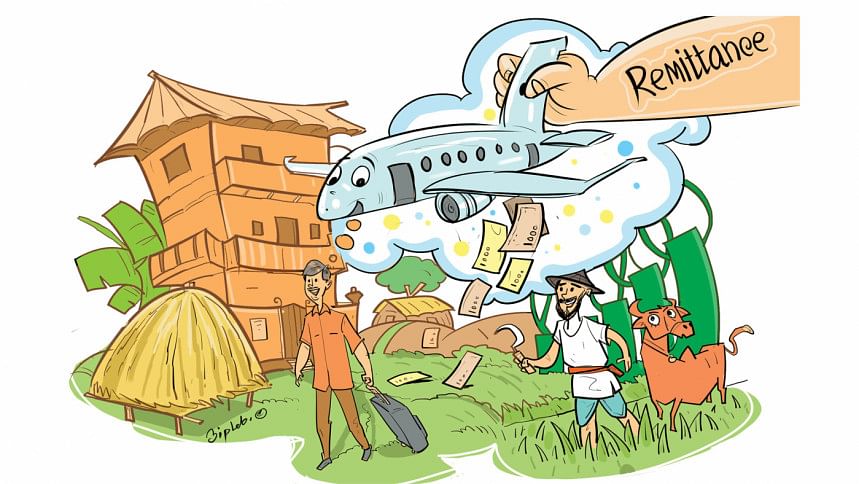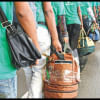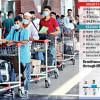Remittance CHANGING rural economy of Bangladesh

Supported by remittance, the families of Bangladeshi migrant workers are playing a crucial role in developing the country's rural economy by not only purchasing goods, but also investing in different small-scale income generating opportunities, according to experts.
Alongside agricultural activities, remittance is a major driver of the rural economy as the inflow of such funds creates more demand for goods and services, they said.
As per a study by the Bangladesh Bureau of Statistics (BBS), styled "Cost of Migration Survey: Bangladesh 2020", about 62 per cent of the 2.7 million workers that went abroad between 2015 and 2018 hailed from rural areas.
Meanwhile, the national statistical agency's "Household Income and Expenditure Survey-2016" published in 2019 says about 68.44 per cent of the remittance received by rural families is used to meet basic need while 27.98 per cent is invested in various ventures.
Professor Mustafizur Rahman, a distinguished fellow of the Centre for Policy Dialogue, said remittance has been playing a big role in boosting non-agricultural activities for the past few decades.
Alongside agricultural activities, remittance is a major driver of the rural economy as the inflow of such funds creates more demand for goods and services
"Remittance has a positive impact on the rural non-farm economy, commercialisation of agriculture and rural small-scale industries," he told The Daily Star.
For example, the families of migrant workers would have to buy rods and bricks should they want to build a house and so, this indirectly stimulates production.
So, it can be said that remittance has a positive "multiplier effect" on the domestic economy in terms of generating employment and raising aggregate demand, he added.
Since the introduction of agent banking in 2013, families of migrant workers in rural areas have received about Tk 1.04 lakh crore in remittance as of December last year, shows Bangladesh Bank data.
This was about 91 per cent of the Tk 1.14 lakh crore worth of remittance received through agent banking during the period.
The country's total inward remittance amounted to Tk 12.54 lakh crore between fiscal years 2013-14 and 2021-22, it added.
Zahid Hussain, former lead economist of the World Bank's Dhaka office, said much of the money remitted by migrant workers is initially spent on repaying the loans taken to send them abroad.
But after those dues are clear, the remittance helps beneficiaries improve their livelihoods.
Different analyses suggest that remittance-receiving families spend more on education, healthcare, food and sanitation compared to other groups of people.
"So, remittance plays a big role in improving the living standards of rural families and ensuring financial security," he added.
To understand correlation between labour migration, poverty and development, the Refugee and Migratory Movements Research Unit (RMMRU), supported by the Swiss Agency for Development and Cooperation (SDC), conducted three surveys in 2014, 2017 and 2020 in rural areas across 20 districts.
The surveyed districts were chosen based on their high, medium or low prevalence of migration while the families of non-migrants and internal migrants were also interviewed.
Last year, the RMMRU published an e-book titled "Impact of Migration on Transformation to Sustainability: Poverty and Development in Bangladesh", based on the findings.
According to the e-book, remittance receiving families fare better compared to non-migrant and internal migrant families when it comes to using agricultural equipment such as irrigation pumps, power tillers and tractors.
For example, 25 per cent of remittance-receiving families use irrigation pumps compared to 24 per cent of non-migrant families and 19 per cent of internal migrant families in 2020.
That year, 47 per cent of the remittance receiving families were involved in poultry farming, 28 per cent in animal rearing, and 6 per cent in aquaculture.
Besides, 1.4 per cent of remittance-receiving families were involved in local enterprises such as textile units, spice mills, saw mills, hotels and restaurants.
Moreover, 8 per cent of them invested in transportation, such as rickshaws, microbuses and trucks, while 12 per cent bought shops in different locations.
The e-book says the poverty rate among 1,565 remittance-receiving families has reduced from 10.9 per cent in 2014 to 6 per cent in 2020.
"It is hard to quantify but the contribution of successful migrants in the country's rural economy is huge," said Professor Tasneem Siddiqui, founding chair of RMMRU and editor of the e-book.
She then said remittance-receiving families possess a better purchasing capacity compared to the general public and tend to buy more goods than others.
"As a result, local markets flourish," Tasneem added.
Remittance is also an important part of sustainable agricultural production as rural remittance-receiving families spend significant amounts on irrigation.
However, it cannot be said that every migrant family is doing equally well in terms of economic progress as there are instances of "failed migration", she said.
Economist Zahid Hussain said a significant portion of inward remittance is a result of migrant workers sending their savings home.
This money is mostly invested in the agriculture and service sectors as the amounts are not large enough to invest in industry, he added.

 For all latest news, follow The Daily Star's Google News channel.
For all latest news, follow The Daily Star's Google News channel. 








Comments